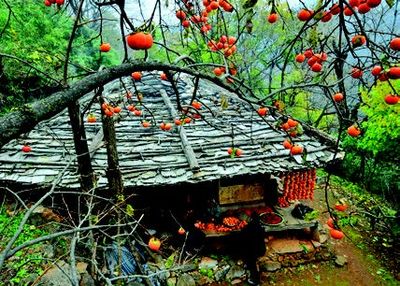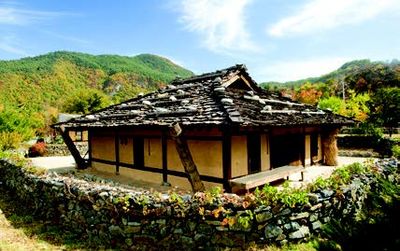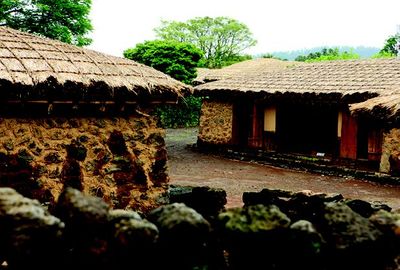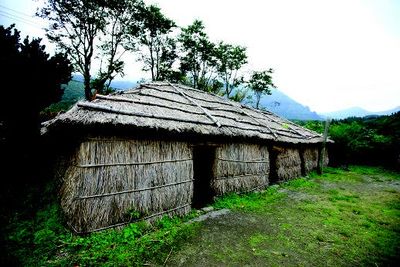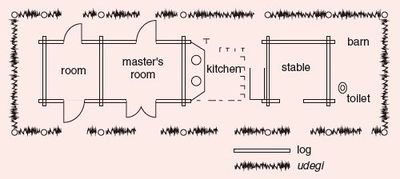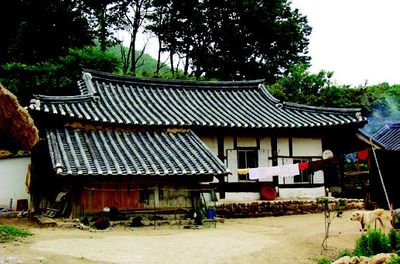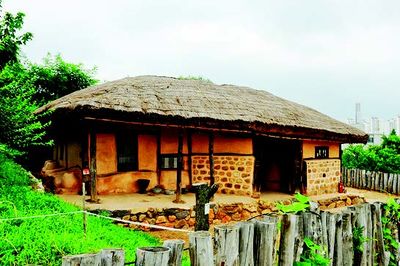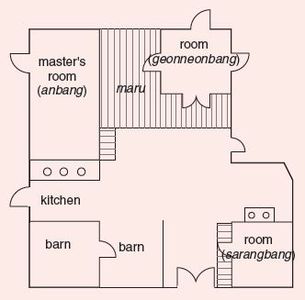The Korean House - ARCHITECTURAL FEATURES THAT REFLECT REGIONAL CHARACTERISTICS
목차
Gulpijip and neowajip in Gangwon-do
The gulpijip (oak-bark-roofed house) and neowajip (shingled house) are found in the northeastern part of the Korean peninsula, as well as in Korea’s more mountainous areas. Since they are located in the mountainous areas, these houses feature double-row room composition to block the cold air and maintain a warm interior space. In this case, because the width of the house is greater, the roof is made to be larger and heavier as well. To reduce the weight of the roof, light roofing materials that can be easily obtained in the local area are used. Gulpijip uses roofing made with the bark of trees such as cone-fruit platycarya, sawtooth oak, and cedar, which all have relatively thick bark. The roofing of neowajip is made of thin pine tree plates that have been split along the grain with a wedge.
Houses on Jeju Island
Due to the temperate climate, houses on Jeju Island usually consist of two linear buildings arranged in a parallel manner with the courtyard in between. The main building is called angeori and the subordinate building is called bakgeori. These houses have a double-row form even with the temperate climate because of the strong winds and typhoons. In other words, the purpose of this closed house arrangement is to improve wind protection while increasing the size of the house. Likewise, other characteristics such as having a low roof tied with straw ropes are also due to concerns about the wind.
Udegijip of Ulleungdo Island
Ulleungdo Island is located in the middle of the East Sea. On Ulleungdo Island, the subordinate spaces such as barns and sheds are attached to the main building. Udegijip (walled house) are surrounded by udegi, which is the freestanding wall installed under the eaves. Udegi is a type of snow wall made by weaving cornstalks and silver grass into the wooden columns that cover the exterior of the building, in order to keep out the snow. Meanwhile, the main building has log-framed walls that are built by stacking the logs up so that they are parallel to the ground. This wall is built in box-frame construction, which offers the advantage of having a solid structure that can withstand heavier vertical loads. Since the structure is required to hold heavy snow loads on the roof, this log-framed wall was chosen over the general wooden structure.[1]
Yangtongjip (two-layered house) of the mountainous Gangwon-do area
For residents in the mountainous area of Gangwon-do, the major production activities are non-rice farming activities that do not require collective labor. As a result, residents tend to live independently instead of forming a village. Therefore, every house in the mountainous area has defensive-styled floor plan, focused on maintaining heating and defense. Contrary to the houses of the plain area that have several buildings to form one house, this compact house has all necessary spaces within one building due to the meaningful use of the building’s exterior spaces. The most common type of yangtongjip in Gangwon-do is the yeokanjip (house with six bays). The interior of the house includes a dirt-floored work space situated between two rooms called a bongdang, as well as a maru at the center of the house.
Ttwarijip of isle regions in the West Sea
The style of house found throughout the coastal area and islands of Gyeonggi-do and Hwanghae-do is called ttwarijip (ring-shaped house), known for its square floor plan. Built on relatively less land than other houses built further inland from the coast, the size of such houses is also smaller than the square-shaped houses inland. The name ttwarijip comes from the ttwari, a ring-shaped object that is used when carrying a load on one’s head, as the opening in the roof above the courtyard in the center of these small thatched houses resembles the hole in the center of a ttwari.[2]
Footnote
- ↑ Kang Yeong-hwan, Saerosseun hanguk jugeomunhwa-ui yeoksa (History of Korean housing culture) (Seoul: Kimoondang, 2002), p. 266.
- ↑ Park Seon-ju and Kim Seong-woo, “Seohae doseominga-ui pyeongmyeonhyeongsik-ui jiyeokjeok teuksaek-e gwanhan yeongu” (A study on the regional characteristics of traditional house plans from the islands of Korea’s West Coast) Daehan geonchuk hakhoe nonmunjip (Journal of the Architectural Institute of Korea) 16, No. 1 (January 2000), p. 48.
